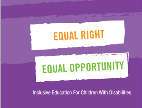Globally, an estimated 93 million children – or 1 in 20 of those aged up to 14 years of age – live with a moderate or severe disability. In most low- and middle-income countries, children with disabilities are more likely to be out of school than any other group of children.
 When a disabled child does get the opportunity to receive a quality education, doors are opened. This enables them to secure other rights throughout their lifetime, fostering better access to jobs, health and other services. For education to play this role as ‘an enabling right’, it must be of high quality, available equitably, built to tackle discrimination and allow each child to flourish according to their own talents and interests.
When a disabled child does get the opportunity to receive a quality education, doors are opened. This enables them to secure other rights throughout their lifetime, fostering better access to jobs, health and other services. For education to play this role as ‘an enabling right’, it must be of high quality, available equitably, built to tackle discrimination and allow each child to flourish according to their own talents and interests.
For International Day of Persons with Disabilities 2013, the Global Campaign for Education launched the new report, "Equal Right, Equal Opportunity: Inclusive Education for Children with Disabilities" which highlights the state of education for disabled children, and how inclusive education delivers the right to quality education for all.
Within the report, recommendations are outlined for national governments, bilateral donors and the international community. Among its strategies to promote inclusive education the report emphasises the need for: creating national plans for inclusion, making schools and classrooms accessible and relevant for all and improving data on disability and education to make children with disabilities more visible to policy makers.

